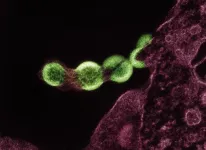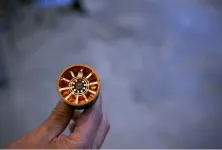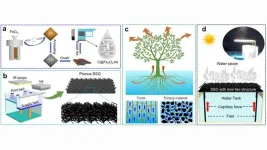A new publication from Opto-Electronic Advances; DOI 10.29026/oea.2024.230202 , discusses an all-optical ultra-long-distance image acquisition and transmission system.
With the exponential growth of data globally, the demand for high-speed acquisition and long-distance transmission of multidimensional data is escalating. Online video surveillance in sectors like industrial manufacturing has significantly boosted productivity while mitigating security risks. Real-time global video calls have revolutionized people's daily lives. Existing systems can leverage high-performance detectors, image sensors, and other technologies to gather carrier information like light, sound, and microwaves. This data is then transmitted back to the operator through various mediums such as cables, networks, wireless communications, and optical fibers. However, in scenarios where narrow or challenging-to-access areas need observation, front-end acquisition equipment and electronic circuits (for tasks like information compression, coding, and modulation) are essential to process the data before transmission. This imposes specific requirements on the system's timeliness and resistance to interference.
In recent years, optical fiber has gained widespread adoption in data transmission due to its low transmission loss and high capacity. Although technologies like wavelength-division multiplexing (WDM) and space-division multiplexing (SDM) using multi-core optical fibers have significantly enhanced system transmission capacity and efficiency, the transmission process still necessitates multiple signal conversions. All-optical acquisition and transmission enable the transfer of image information from one end to the other at the speed of light without the need for additional electronic components. Fiber optic bundles can directly convert and transmit two-dimensional light fields end-to-end, making them crucial in extreme environments such as inaccessible and obscured areas like aerospace, industrial production, and healthcare. However, fiber optic bundles are typically limited in length, costly, and face challenges in ensuring quality during long-distance data transmission due to manufacturing constraints. Researchers have developed various all-optical networks for tasks like information gathering, encrypted transmission, and image classification, which are anticipated to underpin next-generation communications. Nonetheless, these systems encounter practical hurdles in their deployment and are generally compatible only with coherent light sources such as lasers. Hence, there is a pressing need for an efficient, high-capacity, and interference-resistant image acquisition and transmission system.
The authors of this article propose an all-fiber multiplexed parallel acquisition and transmission one-piece system called Multicore Fiber Acquisition and Transmission Image System (MFAT) to tackle the challenges as mentioned above. This study was published in Opto-Electronic Advances 2024, Vol. 6, under the title "Seeing at a Distance with Multicore Fibers." The front-end design, devoid of electronic circuits, obviates the necessity for intricate signal conversion processes, making it suitable for diverse environments and resilient to noise stemming from incoherent light sources. Image data is encoded in the optical domain through optical fiber coupling. The multi-channel characteristics of multi-core optical fibers facilitate high-capacity and high-quality transmission. Furthermore, digital aperture technology enables image recovery and reconstruction from an end-plane image that conceals the original information entirely, thereby enabling real-time scene reconstruction from distances of up to one kilometer.
The image acquisition and transmission process comprises two main stages: encoding and decoding. The encoding phase relies on the principle of fiber propagation mode excitation, where different incident light angles reaching the end faces of distinct fiber cores excite varying propagation modes. In most natural settings, the pattern within each fiber core channel can be perceived as a composite of all object points exciting diverse modes. Consequently, the information from the incident light field is encoded in the spatial and mode components of the multicore fiber for transmission. However, accurately determining the occupancy of each mode is typically challenging and demands substantial computational resources. To address this, the study introduces a cost-effective digital aperture decoding technique based on image processing methodologies to facilitate swift reconstruction. By extracting and computing feature values for different fiber core regions, decoding diverse spatial information within the dimension of fiber transmission modes can be achieved.
This research showcases the system's performance in both direct image transmission and encoded image transmission modes. The direct image transmission mode allows for direct observation of the scene at the far end, while the encoded image transmission can be integrated with digital encoding techniques to enable encrypted transmission of multidimensional data. The concurrent multiplexing of temporal and spatial channels enhances transmission capacity significantly. Moreover, amalgamating polarization, wavelength, and other channel multiplexing techniques further augment the system's transmission capacity. The study also delves into factors influencing the system's reconstruction effectiveness, such as temperature variations, bending, and algorithm robustness. The proposed solution holds significant application value in long-distance image acquisition and transmission, particularly in extreme environments. The interference-resistant compact structure forms the basis for transmitting global high-speed real-time media streams. The exploration and utilization of more multi-dimensional information, coupled with advanced algorithms, presents the potential for developing next-generation all-optical parallel transmission systems.
Keywords: long-distance fiber imaging / image transmission / parallel transmission / all-optical encoding / multicore fiber
# # # # # #
Professor Fei Xu, Ph.D. supervisor of the College of Engineering and Applied Science, Nanjing University, National Outstanding Young Scientist Fund recipient, SPIE Fellow, Optica /IEEE Senior Member, mainly engaged in photoelectric intelligent perception related research, so far has published 9 relevant English monograph chapters, invited reviews >20. He has been granted >50 patents, 4 PCT and US patents, and published >170 SCI papers in journals including Nat. Commun., Sci. Adv., Optica, Light: Sci. Appl., Adv. Photonics, Adv. Mater. etc. Prof Fei Xu's homepage: https://eng.nju.edu.cn/xf/main.htm
Using optical fibers as a carrier, the group has independently and autonomously developed optical fiber integrated devices and systems with ultra-high precision and ultra-strong performance after more than ten years of accumulation of high-precision processing technologies such as micro processing and femtosecond machining and explored their cutting-edge applications in aerospace, medical diagnostics, optical fiber communication, security monitoring, biochemical analysis, and other fields. With the support of national major needs and key projects, the group focuses on scientific issues in next-generation optical fiber integration, human-computer interaction, and computational perception, and carries out innovations in advanced optoelectronic devices and integration methods, as well as algorithms and architectures of new models through cross-fertilization of disciplines such as physical optics, materials science, electronics, machine learning, micro nano-optics, and computer vision.
# # # # # #
Opto-Electronic Advances (OEA) is a rapidly growing high-impact, open access, peer reviewed monthly SCI journal with an impact factor of 15.3 (Journal Citation Reports for IF2023). OEA has been indexed in SCI, EI, DOAJ, Scopus, CA and ICI databases, and expanded its Editorial Board to 31 members from 17 countries with an average h-index of 62.
The journal is published by The Institute of Optics and Electronics, Chinese Academy of Sciences, aiming at providing a platform for researchers, academicians, professionals, practitioners, and students to impart and share knowledge in the form of high quality empirical and theoretical research papers covering the topics of optics, photonics and optoelectronics.
# # # # # #
More information: http://www.oejournal.org/oea
Editorial Board: http://www.oejournal.org/oea/editorialboard/list
All issues available in the online archive (http://www.oejournal.org/oea/archive).
Submissions to OEA may be made using ScholarOne (https://mc03.manuscriptcentral.com/oea).
ISSN: 2096-4579
CN: 51-1781/TN
Contact Us: oea@ioe.ac.cn
Twitter: @OptoElectronAdv (https://twitter.com/OptoElectronAdv?lang=en)
WeChat: OE_Journal
# # # # # #
Feng HG, Chen X, Zhu RZ et al. Seeing at a distance with multicore fibers. Opto-Electron Adv 7, 230202 (2024). doi: 10.29026/oea.2024.230202
END




